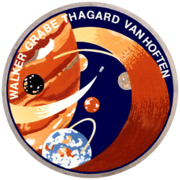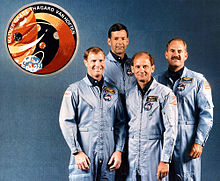STS-61-G
This article needs additional citations for verification. (June 2015) |
| Mission type | Spacecraft deployment |
|---|---|
| Mission duration | 4 days, 1 hour, 11 minutes planned |
| Spacecraft properties | |
| Spacecraft | Space Shuttle Atlantis |
| Crew | |
| Crew size | 4 |
| Members | David M. Walker Ronald J. Grabe Norman E. Thagard James van Hoften |
| Start of mission | |
| Launch date | 20 May 1986, 20:21:00 UTC Never launched |
| Launch site | Kennedy LC-39A |
| End of mission | |
| Landing date | 24 May 1986, 21:32:00 UTC |
| Landing site | Kennedy Runway 15[citation needed] |
| Orbital parameters | |
| Inclination | 28.45 degrees |

 Left to right: Walker, Grabe, Thagard, van Hoften | |
STS-61-G was a United States Space Shuttle mission planned to launch on May 20, 1986, using Atlantis. The main objective of this mission was to launch the Galileo spacecraft toward Jupiter using the Centaur-G upper stage. It was canceled after the Challenger disaster.
Crew[]
| Position | Astronaut | |
|---|---|---|
| Commander | David M. Walker Would have been second spaceflight | |
| Pilot | Ronald J. Grabe Would have been second spaceflight | |
| Mission Specialist 1 | Norman E. Thagard Would have been third spaceflight | |
| Mission Specialist 2 | James D. A. van Hoften Would have been third spaceflight | |
Crew notes[]
John M. Fabian was scheduled to fly as Mission Specialist 1 on his third trip to space, but he took advice from his wife who had earlier told him that "his marriage had a two-flight limit", he soon resigned from this mission.[1] His replacement was Norman E. Thagard.[2] Most of the crew sans van Hoften flew on STS-30 in May 1989, with Mary Cleave taking the place of van Hoften and the addition of rookie Mark Lee. Galileo was launched on STS-34 in October 1989, using the Inertial Upper Stage booster instead of the Centaur-G (which was canceled in 1986).
See also[]
References[]
- ^ NASA. "Fabian Interview". NASA.gov. NASA.
- ^ "The new shuttle crews are named". Lodi News-Sentinel. Lodi, California. 20 September 1985.
- Cancelled Space Shuttle missions
